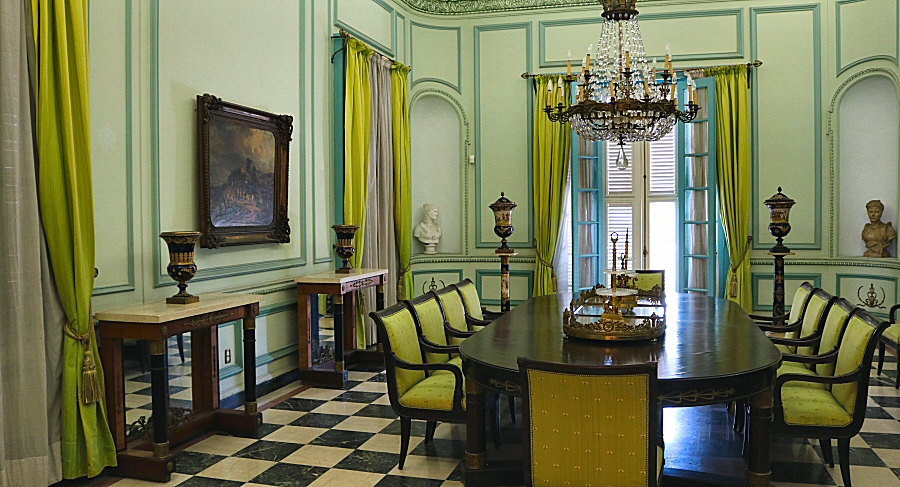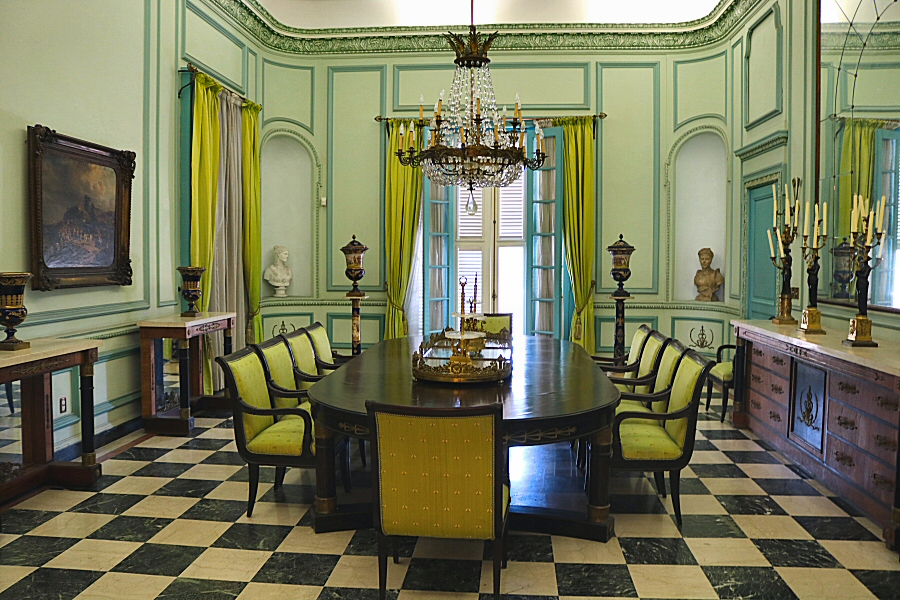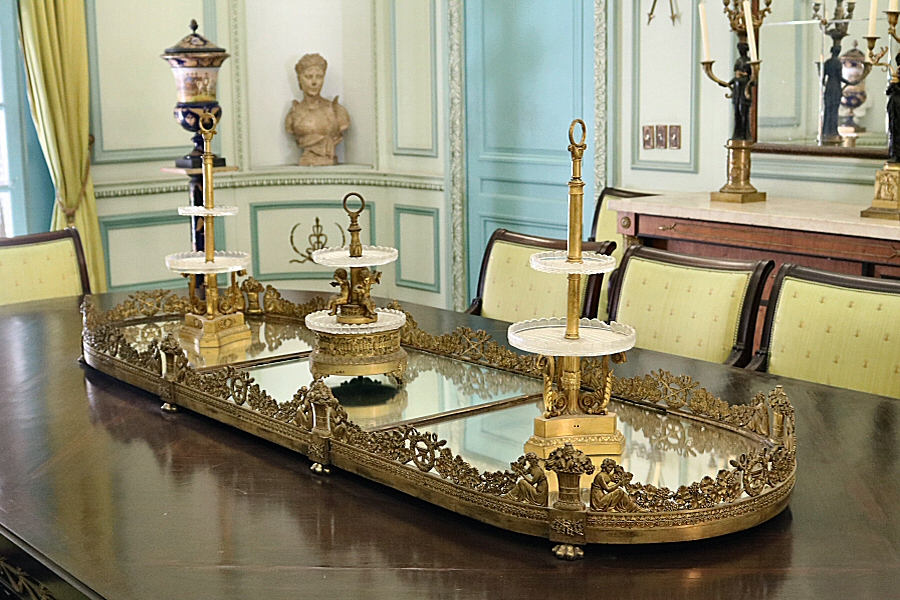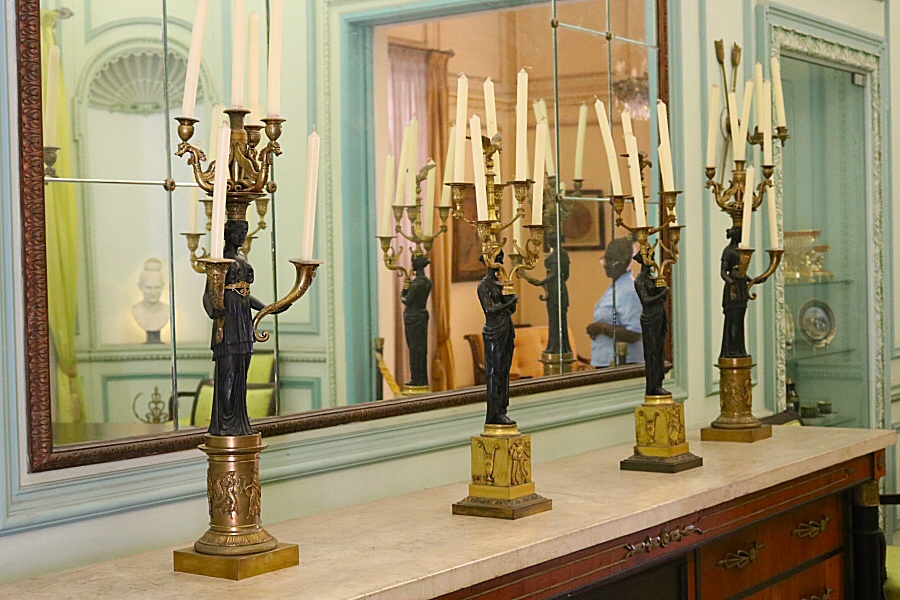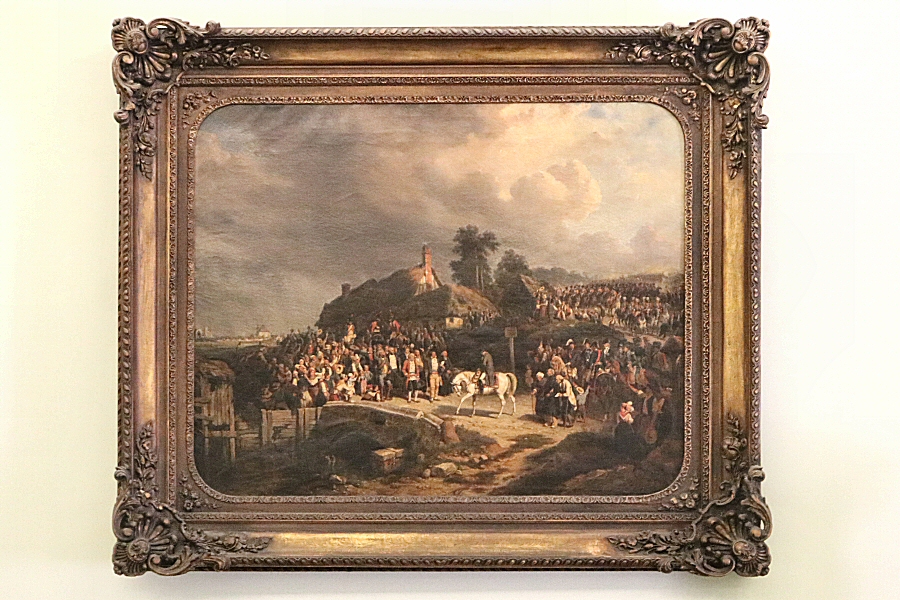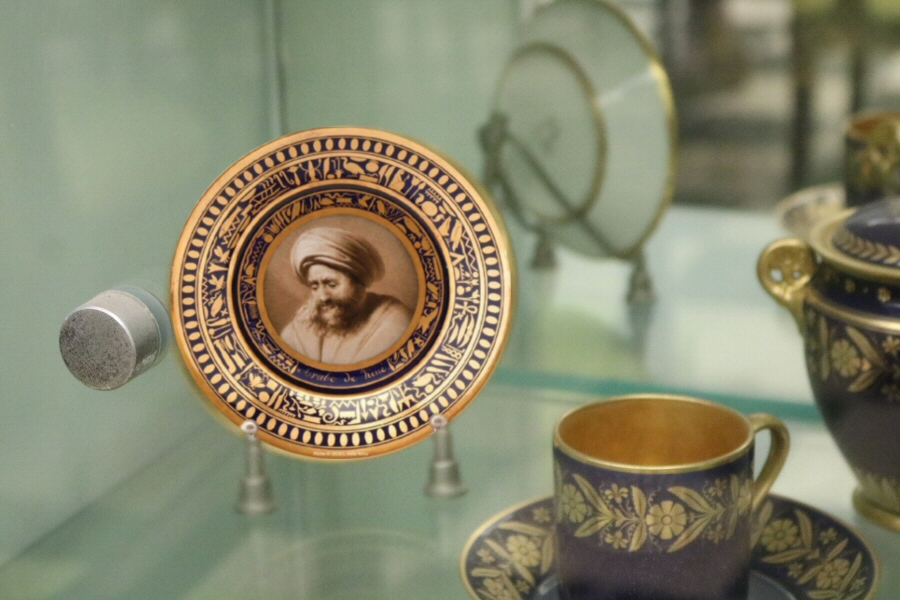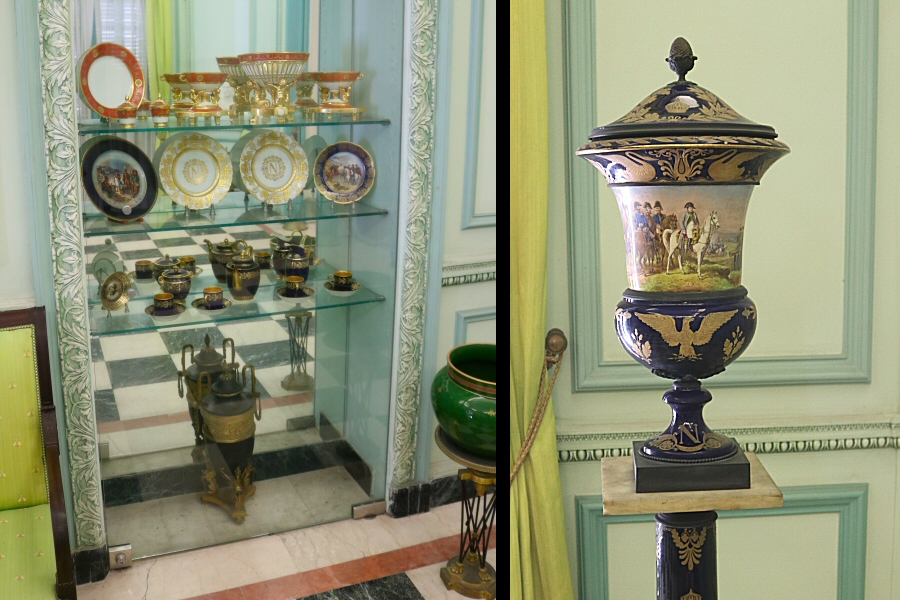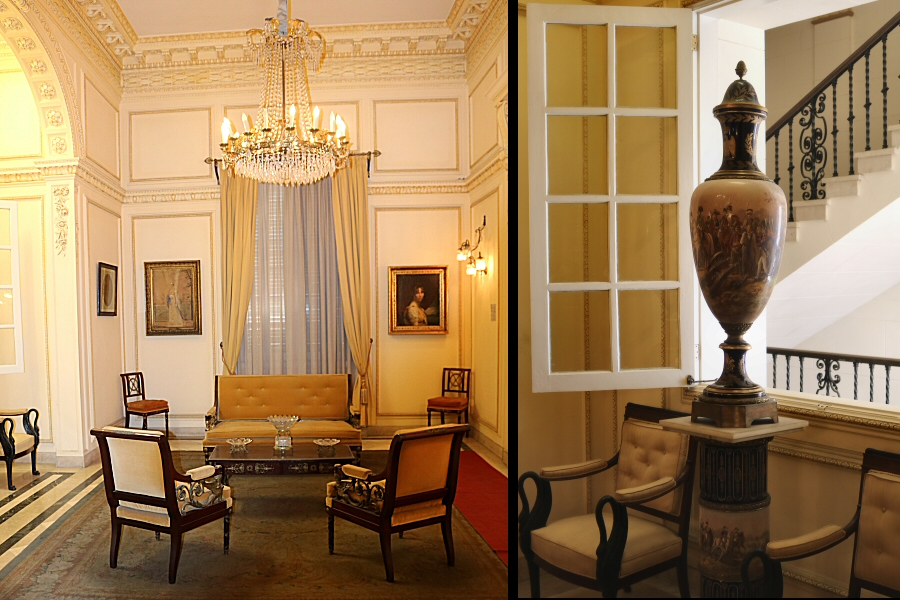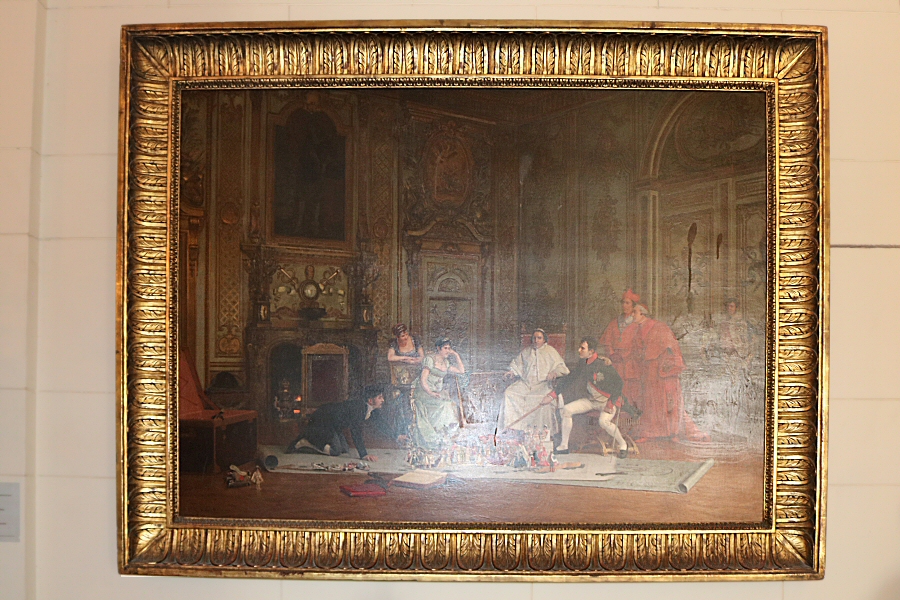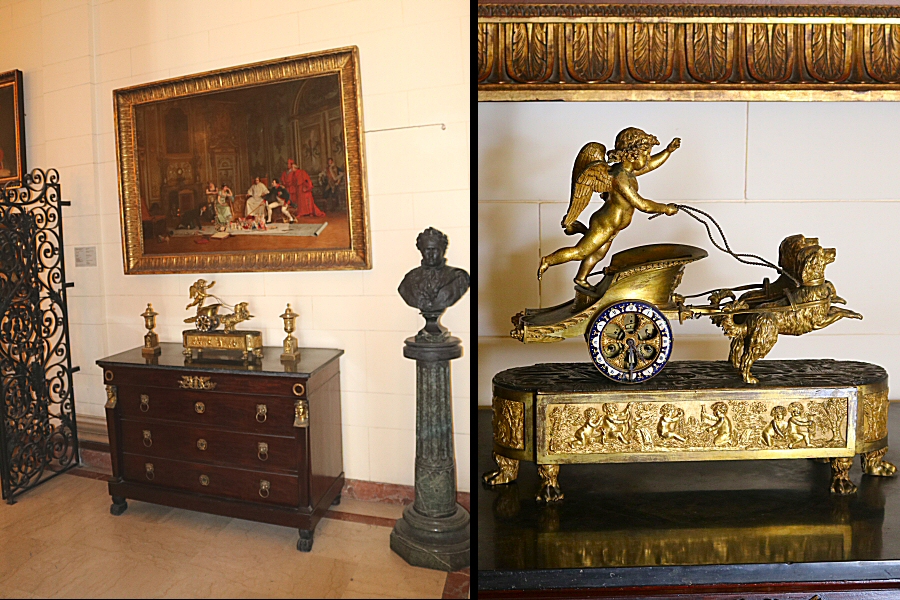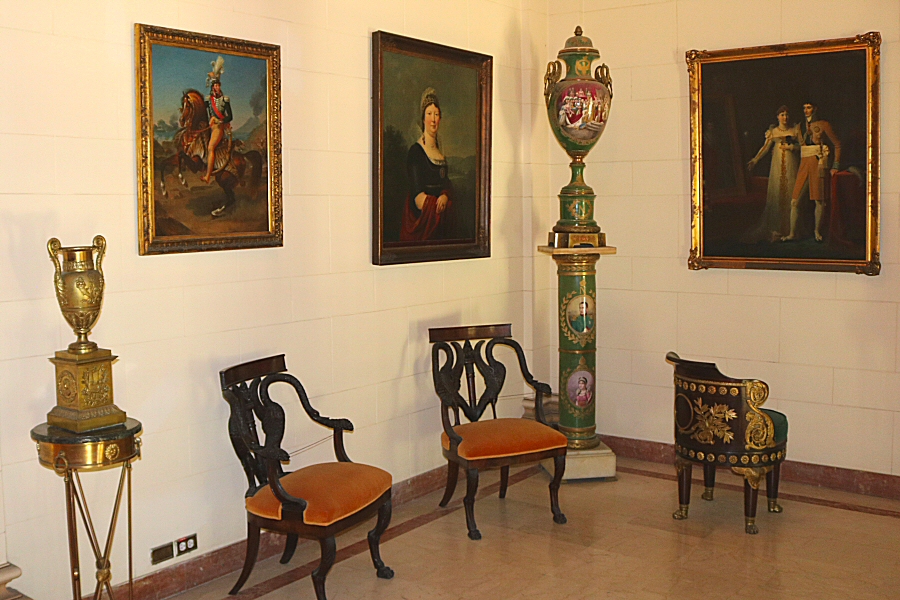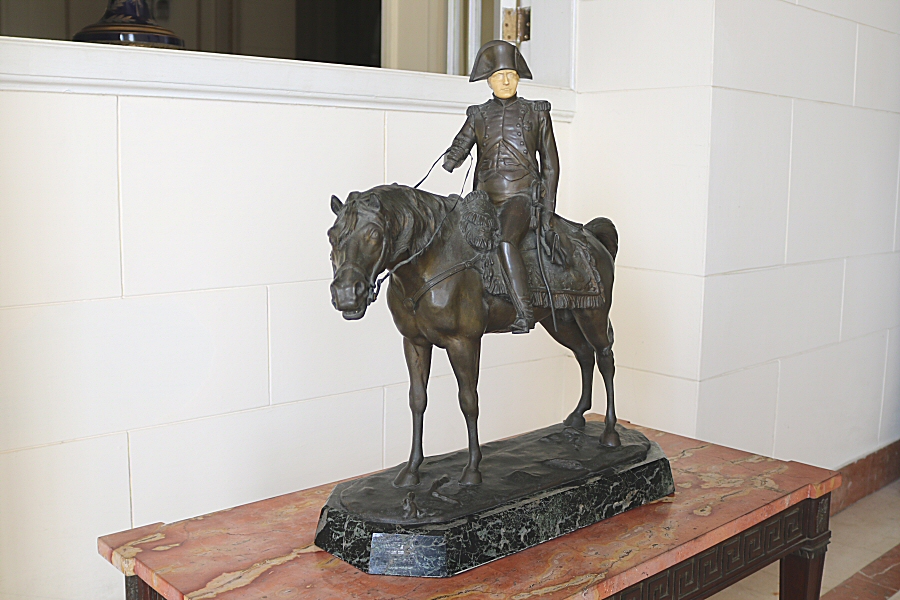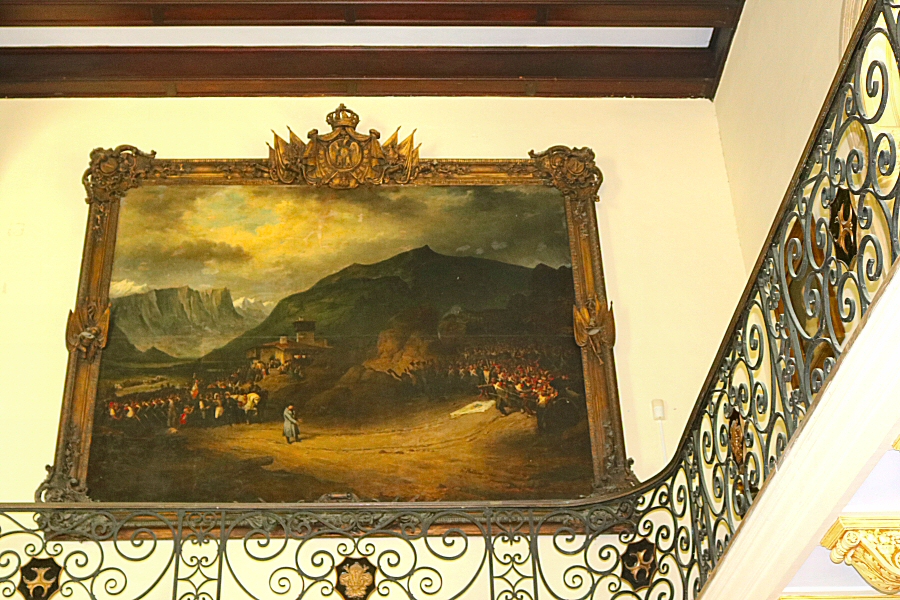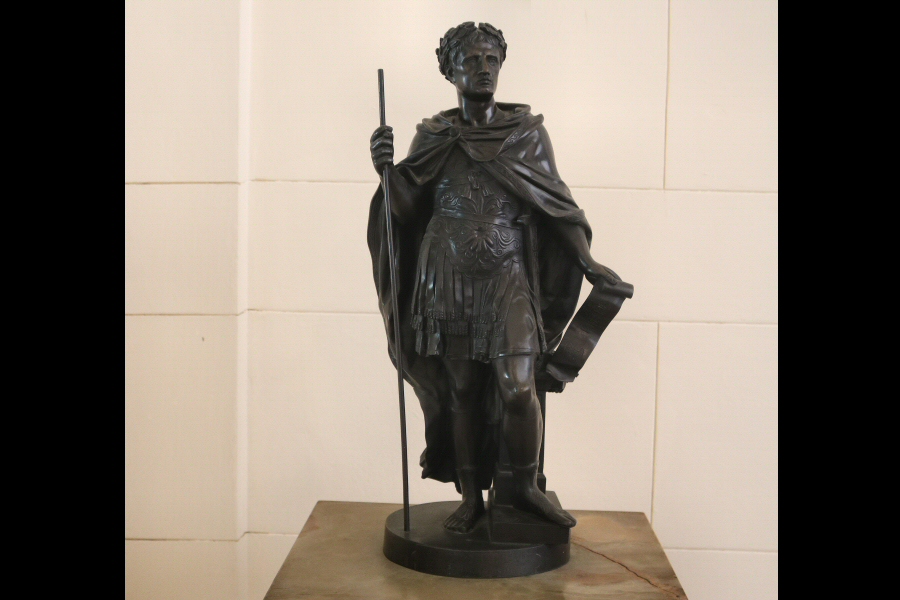
The second floor consists of the dining
room, preceded by a hall, a room with paintings and decorative
elements and the corridor that surrounds the Grand Salón.
The dining room is the most elegant room of
the mansion. The walls are painted in light green, whereas the
ground is paved with checkered black and white marble. The room
is illuminated by a crystal chandelier and two pairs of
candelabras on the console with a gigantic mirror. The
candelabras have gilded candle mounts. One pair stands on a
rectangular base, the other pair on a round base. One pair has
interchangeable candle mounts. The hands of the woman figure
carry two candles, whereas three candles are placed on her head.
Their artisan of all candelabras is unknown, but their high
quality is quite visible. The corners of the dining room are
rounded and contain niches, in that white marble woman
sculptures are placed. The grass-green curtains are in good
harmony with green color of the chairs of the dining table. The
dining room is enriched by a pair of ornamental campaign style
Sévres urns and two large campaign style vases. The one-meter
high vases are the work of H. Desprez from Sévres. On the vases
we see Napoléon, when he was in Austerlitz in 1805 and in
Friedland in 1807.
The imperial style dining table is a
reproduction, manufactured in 1950s. A splendid ‘surtout de
table’ (a decoration that is placed at the center of a table) is
placed on the dining table. It is composed of three mirror
pieces that constitute the base. Two fruit stands and a candy
stand, made of bronze and glass, are placed on it. It is the
work of the renowned French bronzier Pierre Philippe Thomire
that made it in 1751. This piece belongs to the large Thomire
collection of the museum. It is a possibility that Julio Lobo
ordered the dining table, after he purchased the amazing ‘surtout
de table’. The ‘surtout de table’ was the constant feature of
the dinner services in imperial palaces, manufactured
particularly in Sévres; some of them were even several meters
long.
The porcelain dinner set,
exhibited in the dining room, deserves to have a look. The
porcelain plate, embellished in gold, contains the first letter
of the name of the Emperor at the center and it surrounded by
swan motifs, the symbol of his first wife Joséphine. However,
the most interesting piece of the porcelain tableware collection
is the saucer of the famous Egyptian cabaret service, called
Arabe de Kené (Qena is a city in the upper Egypt,
situated on the east bank of the Nile) and made by the
Manufacture de Sèvres that produced several sets for the
imperial palace. It is likely that this saucer belongs to the
fourth set, manufactured for Napoléon in 1810. The French
painter Jacques François Joseph Swebach-Desfontaines had great
contribution in the manufacturing process of the Egyptian set.
Napoléon liked the set very much, so that he presented some
pieces of the set to his close relatives and took the rest with
him to St. Helena island. The saucer was donated to the Museo
Napoleónico by the Princess Napoléon on the occasion of the
reopening of the museum in 2011.
The furniture (the armchairs, the chairs and
the sofa) that we see in the hall, preceding the dining room,
were brought from the house of Joseph Bonaparte, Napoléons
oldest brother, in Switzerland, from so-called Château de
Prangin. Julio Lobo purchased all these in 1950s, as he wanted
to decorate a room with items related with Joseph Napoléon. The
armchairs have bronze mounts of winged sphynxes. With its cream
color decoration, the hall constitutes an elegant place of the
second floor. The hall contains also the portraits of Hortense
de Beauharnais and Joséphine de Beauharnais, a lithograph of the
entire Napoléonic family, and a nice crystal chandelier from the
Château de Malmaison.
The portrait of Hortense Eugénie Cécile
Bonaparte de Beauharnais, Queen consort of Holland, by Francois
Pascal Simon Gérard is another valuable piece of the museum. She
was the stepdaughter of Napoléon Bonaparte, being the daughter
of his first wife Joséphine. She later married Napoléon’s
brother Lousi Bonaparte, the King of Holland, and became the
mother of Napoléon III, the Emporer of the France. The oil
canvas is the work of the French painter Baron François Gérard.
In the watercolor painting, Joséphine de
Beauharnais holds a sprig of flowers in her left hand, making a
reference to the rose gardens for that she devoted herself. A
small detail: the tree on her right side has a broken branch,
bringing her short life to mind (Joséphine died at the age of
51). The painting is the work of Jean-François Bosio.
In the next room, there are several oil
paintings, among which The Planning for the Coronation (La
planification du Couronnement) by the French painter
Jean-Georges Vibert is maybe the most known. In the oil painting
Napoléon is represented during the rehearsal of his coronation
as Emperor by rearranging dolls on a floor plan of Notre Dame
Cathedral. The lady in the painting that is leaning on the
table, is Joséphine and looks rather bored. The man on his
knees, setting up the dolls, is the Jean-Baptiste Isabey, the
French painter that got great credit by Jospehine. The
ecclesiastics that sits on the right side of Napoléon is Pope
Pius VII that looks uncomfortable because of the rise of
Napoléon to Emperor. Vibert painted two versions of this
painting; this is the larger one that passed into the hands of
Julio Lobo in 1935.
Below the painting, there are a pair of
gilded bronze candlesticks, placed on a console with drawers,
made of mahogany. These candlesticks were used by Joseph
Bonaparte.
“King of Naples Joachim Murat on Horseback”
is another important oil painting in the room. It is the work of
Baron Antoine-Jean Gros that completed in 1811. Murat
commissioned Antoine-Jean Gros to make his portrait with similar
outlook like in his masterwork, entitled “The Battle of Aboukir,
July 25, 1799”. In that painting Murat was represented on a
horse, leading a rescue operation against the crowded Ottoman
cavalry. In the “King of Naples Joachim Murat on Horseback”,
Murat is represented on a rampant horse with his Mamluk sword in
the scabbard. He uses a tiger peltry as the saddle.
An interesting oil canvas is the portrait of
Jérôme Bonaparte, the youngest brother of Napoléon, with
Catherine of Württemberg. The royal couple (King and Queen of
Westphalia) are represented as paying homage to a painting of
Napoléon Bonaparte, seated on a throne. Catherine is wearing a
flamboyant necklace and the royal crown. She makes a gesture to
the painting of Napoléon Bonaparte, while Jérôme is holding his
wife at her waist. He wears the Order of the Crown of Westphalia
around his neck and the Breast star of the Order on his chest,
both signifying his statute despite his modest dress that is in
great contrast with the chic design of his wife’s dress. On the
wall behind them, there are several portraits of the Bonaparte
family members. The oil painting is the work of Marguerite
Gérard, and it was painted after Napoléon appointed Jérôme as
King of Westphalia in 1807. However, later Napoléon considered
his decision to be a great disappointment. There is another
almost identical painting by François Joseph Kinson that was the
court painter of the King of Westphalia. They differ only in the
localization of the small black dog: in this painting, Catherine
cradles the dog in her arms, but in the Kinson’s painting, the
dog is sitting on the throne.
In the same room you will find two gilt
bronze pedestal tables, on which gilt bronze craters are placed.
The pedestal tables have circular brocatelle marble at the top
that are supported by three legs that are connected to each
other with gilt bronze rosettes. The triangular base, on that
the pedestal table stands, has nice lion paws. The ornately
designed bronze craters have several embossments, like lyres,
flowers, rosettes and women. Their artisan is unknown.
The oil portrait of Paulina Borghese
(Bonaparte), Napoléon’s sister, with Joséphine’s swan armchair
below, constitute one of the pleasant corners of the second
floor. The former is the work of the French painter Robert
Lefèvre that painted it in 1806. The latter, although unmarked,
is speculated to be the work of Jacob Frères as the manufacturer
and Charles Percier as the designer. All the classic
empire-style motifs are incorporated in the gold-painted
armchair: palm leaves, Greek and Roman imagery, military torches
for front legs, Egyptian forms for the back legs, highly
embroidered textile and, of course, Joséphine’s symbols, the
swans.
The bronze sculpture of Napoléon is another
valuable piece of the museum on the second floor. It is the work
of the French sculptor Pierre Alexandre Tardieu. Napoléon looks
like a Roman Emperor, powerful and glorious. The names of the
famous ancient Roman poets, Virgil, Horace and Pliny, are
written on the scroll that he holds in his left hand.
There is a big size oil painting, hung on
the balconies of the second floor: the oil painting by Hippolyte
Bellangé, entitled Napoléon au retour de l’île d’Elbe (Napoléon
Returning from the Island of Elba). The oil painting has a
spectacular frame, ornamented with carvings in the shape of oak
leaves and the Légion d'honneur medal. Also, the names of some
of the battles of Napoléon Bonaparte, ended with victory, as
well as the first letter of his name, are carved on the frame.
After the defeats in Germany and France, Napoléon was forced to
abdicate the throne voluntarily, and subsequently, he was sent
to the Elba island in Italy. About ten months later Napoléon
left the island secretly with about thousand men and began to
walk to Paris. The painter portrays the scene, known as La
Prairie de la Rencontre (the Meadow of the Meeting), in that
Napoléon met the Royal infantry at Laffrey close to Grenoble
that was sent to arrest him in 1815. Napoléon ordered his men to
lower their rifles, proceeded alone to the infantry and stopped
in front of them. Many of these soldiers served him in many
campaigns. He reproached by spreading his arms wide: You will
shoot your Emperor? His resolute attitude led the soldiers to
drop their rifles and to warmly greet their Emperor. A few weeks
later Louis XVIII fled from France and Napoléon Bonaparte
ascended to the throne again without firing a single shot.
On the way to the third floor you will see
bronze sculpture of Napoléon, represented as Roman Enmperor. The
names of Virgil, Horace and Pliny can be read on the scroll that
he holds in his left hand. It is the work of the sculpture
Pierre Alexandre Tardieu that wanted to show the emperor
powerful and glorious.
